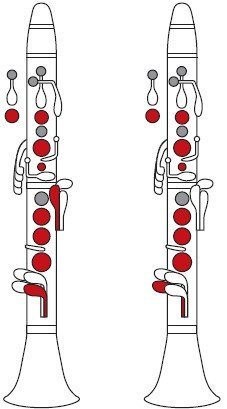Introduction to the F# Half-Whole Diminished Scale
The F# Half-Whole Diminished Scale holds a special place in clarinet music. Its pattern of alternating half and whole steps creates a unique sound that offers clarinetists many possibilities for harmony and improvisation. This scale isn't just a technical exercise; it's a powerful tool for expressing emotions and creating complex melodies.

Clarinet Fingering Charts are always FREE at MartinFreres.net!
Origins and Versatility
Musicians developed the F# Half-Whole Diminished Scale as they searched for fresh ways to expand their musical language. Its appeal lies in its flexibility – it fits well in jazz, classical, and modern music, giving clarinetists the freedom to experiment across different styles. Since its creation, this scale has been a go-to for musicians wanting to stretch the limits of what's possible on the clarinet.
Jazz and the F# Half-Whole Diminished Scale
In the jazz world, famous clarinetists like Barnet Peet and Eddie Daniels embraced the F# Half-Whole Diminished Scale. They used its unique qualities to create intricate solos that showed off both their skill and their ability to convey emotion. When a jazz clarinetist uses this scale in an improvisation, it's similar to an artist adding vibrant colors to a painting, bringing their music to life.
Structure and Emotional Impact
The way this scale is built allows it to create a wide range of feelings in music. It can build tension and then release it, which suits the clarinet's expressive nature perfectly. Players who really understand the F# Half-Whole Diminished Scale can use it to tell musical stories filled with different emotions.
| Scale Degree | Note | Interval |
|---|---|---|
| 1 | F# | Root |
| 2 | G | Half step |
| 3 | A | Whole step |
| 4 | B? | Half step |
| 5 | C | Whole step |
| 6 | D? | Half step |
| 7 | E? | Whole step |
| 8 | F | Half step |
The Importance of Instrument Quality
The clarinet itself plays a big role in how the F# Half-Whole Diminished Scale sounds. Martin Freres clarinets are well-known for their quality, which helps musicians play to their best ability. These clarinets produce warm tones and respond well to the player, making the F# Half-Whole Diminished Scale sound even better across all ranges. Playing this scale on a Martin Freres clarinet can create truly impressive music.
Technical Aspects of the Scale
The F# Half-Whole Diminished Scale includes these notes: F#, G, A, B, C, D, E, and F. Many players practice this scale to get ready for difficult parts in their music or to improvise smoothly during shows. The half-whole pattern is also great for exploring unusual modes, which can add more variety to a clarinetist's playing style.
Performance Techniques
When playing the F# Half-Whole Diminished Scale, clarinetists can play around with volume, different ways of tonguing notes, and various fingerings to make each performance unique. Using this scale opens up chances to try out tiny pitch changes and special effects, mixing traditional and modern styles to give listeners a new way to experience clarinet music.
Educational Impact
Over time, teaching methods for this scale have changed. More and more teachers are including it in their lessons, showing how important it is not just for solo playing but also for group performances. The harmonies you can create with this scale help groups play together in exciting ways that still sound good.
Influence Across Musical Genres
The F# Half-Whole Diminished Scale isn't just for jazz. Classical composers also like to use its complex sound to create powerful moments in their music. This scale has become a permanent part of clarinet playing, from students practicing to professional musicians performing in big concert halls.
Conclusion
If you love playing the clarinet, you should definitely try out the F# Half-Whole Diminished Scale. Use it when you practice and perform, learn about where it came from, and see how it can make your music better. Whether you're playing jazz late at night or adding depth to a classical piece, this scale will help you. Martin Freres clarinets are great for playing this scale, letting you combine melody, harmony, and feeling into unforgettable music.







